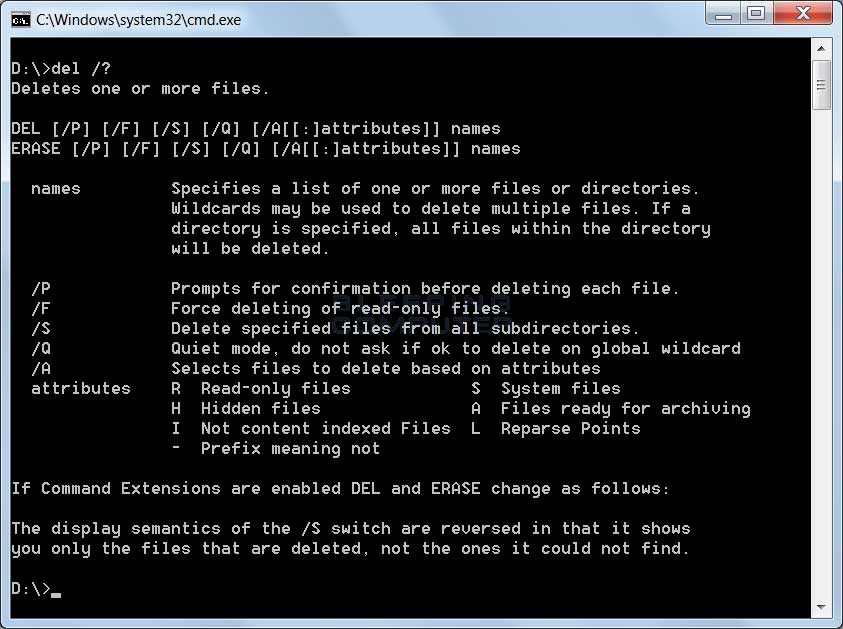

- #Net use force delete install
- #Net use force delete serial
- #Net use force delete windows 7
- #Net use force delete windows
If this does not work, you probably selected the wrong hub in step 4.
#Net use force delete windows
Now, Windows will remove and re-detect the hub and any USB devices attached to it, re-enabling them in the process. Note: If your user interface devices such as a mouse or keyboard, or any other USB devices such as a USB Network Adapter are on the same root hub as the USB device you are trying to re-detect, then you will lose connectivity to your mouse or keyboard while the restart is performed. Once you have navigated to the proper directory, type in the following command followed by enter, replacing ROOT_HUB20 with what you recorded in step 4: devcon restart *ROOT_HUB20* If you are using a 64-bit operating system, you need to ensure you are calling the 64-bit version of devcon.exe. In the Command Prompt window, first change directory to the folder that contains the devcon.exe file that you downloaded.  Next, start a Command Prompt by going to Start » Run, type in cmd, and then click the OK button. Record the name shown in the list between the first and second \ sign, for example ROOT_HUB20
Next, start a Command Prompt by going to Start » Run, type in cmd, and then click the OK button. Record the name shown in the list between the first and second \ sign, for example ROOT_HUB20 #Net use force delete windows 7
If you are running Windows 7 or Windows 10, select Device Instance Path instead of Device Instance Id. When you have found the hub that has your device listed, click the Details tab and select Device Instance Id from the drop down menu.You can double click on every USB Root Hub entry and click the Power tab to see if your device is listed.
#Net use force delete serial
To do this, expand the Universal Serial Bus controllers group at the bottom of the list. You will now need to determine which USB hub (port) the troubled device is connected to.Open the Windows Device Manager by going to Start » Run, type in devmgmt.msc, and then click the OK button.Using DevCon, you can enable, disable, restart, update, remove, and query individual devices or groups of devices. The DevCon utility is a command-line utility that acts as an alternative to Device Manager.
#Net use force delete install
Install the DevCon Utility from Microsoft. In either case, the device is not re-detected by the computer and thus you will not be able to communicate with it.įollow the instructions below to re-detect the device within Windows when this happens: Also, this can happen when a computer returns from having been hibernated. For example, often when a computer goes into standby or power-save mode it will often shut down power to the USB ports. VolumeName begins with \\ and all available volumes are listed when you run mountvol /?.This behavior occurs when the device loses power, but the computer does not. 
Use the command mountvol d: VolumeName To reassign a drive letter. The command mountvol d: /D removes the drive letter from volume D: Use the /D parameter to remove a drive letter from the selected volume. A good starting point is the command mountvol /? which lists all supported parameters and all volumes similar to the listing that you get when you run the Disk Management interface. You can use the command mountvol to interact with volumes.
Type cmd.exe, hold down the Shift-key and Ctrl-key, and select the item from the list of results. Tap on the Windows-key to display the Start Menu. You need elevated rights to remove a drive letter using the command prompt: Removing drive letters using the command prompt The only difference is that you need to select add and pick one of the available drive letters. You may add drive letters to volumes using the same step by step guide. The change is reflected in Explorer and other file browsers as well. If you selected remove, the drive letter should no longer be attached to the volume. Select yes to continue with the execution or no to cancel it.ĭisk Management closes the prompt automatically and visualizes the change in its interface. Removal is not an issue if the volume is not used but it may cause issues if it is used by programs, for instance for data storage. Are you sure you want to remove this drive letter? Some programs that rely on drive letters might not run correctly. To remove it, select it and then the remove button to execute the action.ĭisk Management displays a warning prompt when you select remove: The interface lists options to add, change or remove the drive letter. You may use it to execute all supported operations select "change drive letter and paths." in this case to remove the drive letter from the partition.ĭisk Management lists assigned drive letters of the volume in a new window when you select the option.







 0 kommentar(er)
0 kommentar(er)
